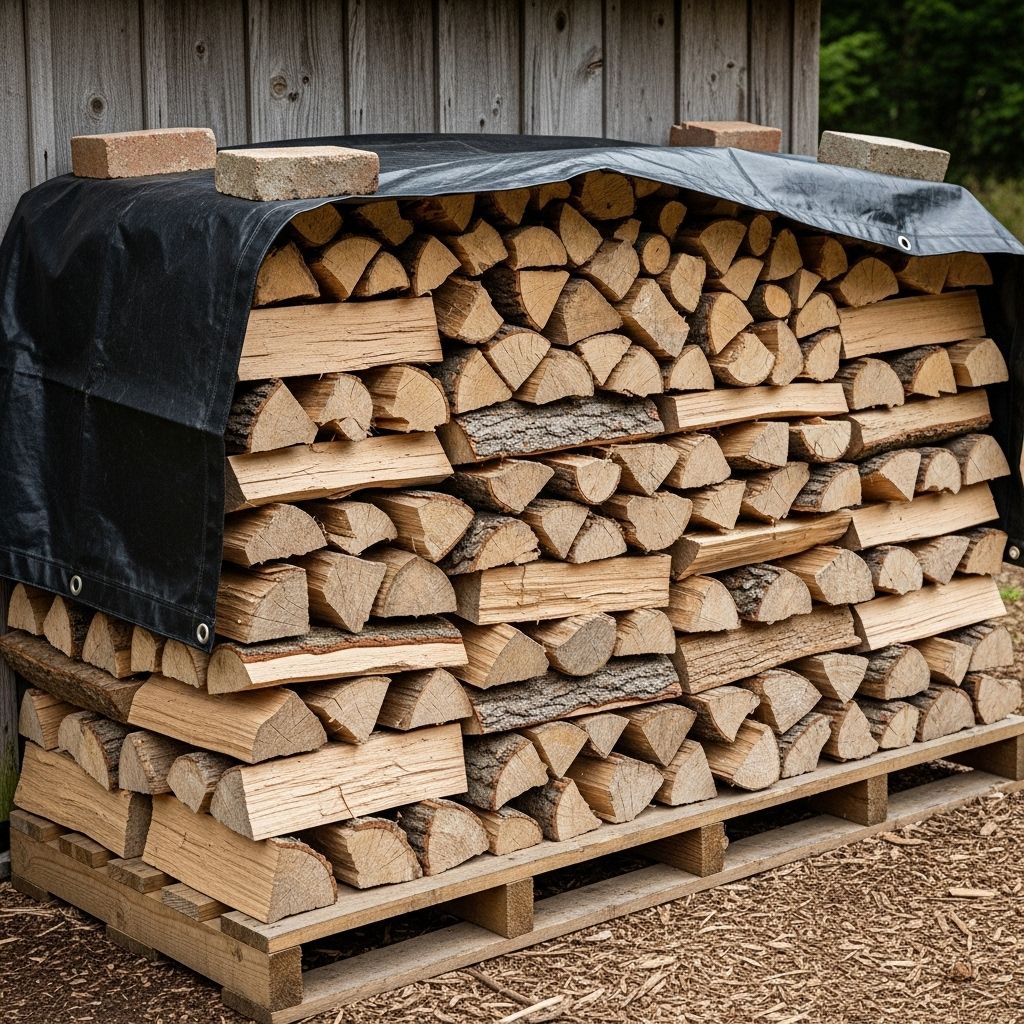How To Store Firewood: 6 Essential Steps For Dry, Seasoned Logs
Keep logs dry and ready all season with expert advice for safe and efficient stacking.

Image: HearthJunction Design Team
How to Store a Cord of Firewood: Tips, Techniques, and Best Practices
For those who enjoy the warmth and comfort of a wood-burning stove or fireplace, knowing how to properly store a cord of firewood is essential. Incorrectly stored wood can become damp, rot, attract pests, and burn poorly, while well-stored wood stays dry, seasons thoroughly, and produces efficient, long-lasting fires. This comprehensive guide covers everything you need to know about stacking, storing, and maintaining firewood, ensuring your home stays cozy all winter long.
What Is a Cord of Firewood?
A cord is the standard unit of measurement for firewood. It refers to a tightly stacked pile measuring 4 feet high by 4 feet wide by 8 feet long, totaling 128 cubic feet of wood (including air space between the pieces). It’s the typical quantity delivered or purchased for residential heating purposes and is important for comparing pricing and planning storage space.
Why Proper Firewood Storage Matters
- Prevents Moisture Retention: Wet or damp wood is difficult to light and produces more smoke, less heat, and more creosote buildup in chimneys.
- Promotes Seasoning: Storing firewood correctly helps it dry out (or season), which is necessary for clean and efficient burning.
- Reduces Pest Problems: Proper storage keeps insects, rodents, and fungal growth at bay.
- Ensures Safety: Safe stacking techniques prevent woodpiles from toppling, which can cause injuries or property damage.
Choosing the Right Location for Firewood Storage
The location of your firewood stack is crucial. Consider these factors:
- Outdoor Storage: The best place for most firewood is outdoors, where air can circulate freely to aid drying.
- Distance From Home: Store firewood at least 20–30 feet from your house or other structures to reduce the chance of pest infestations spreading indoors.
- Elevation: Avoid placing stacks directly on the ground. Use pallets, firewood racks, or bricks to raise the wood and prevent moisture absorption from soil.
- Sunlight & Airflow: Choose a location that receives good sunlight and cross-ventilation to speed up the seasoning process.
- Avoid Overhanging Branches or Roofs: These can drip water onto the stack and slow drying.
Types of Firewood Storage Structures
Firewood can be stacked and stored using various structures, each with its own benefits:
- Simple Stacks:
- Rows of wood pieces are stacked together with a vertical stop at one or both ends, such as a board or perpendicular wood columns.
- This method maximizes airflow and is easy to build anywhere.
- Round Stacks:
- Wood is piled in a circle with the ends meeting in the middle, forming a starburst pattern.
- Round stacks are more compact and stable, but airflow can be slightly restricted, potentially increasing drying time.
- Crib Stacks:
- A square or rectangular ‘crib’ is built with alternating layers of wood logs (like a log cabin structure) at the ends, which acts as a support for the main stack.
- Crib stacks improve stability for high piles and help contain the stack.
- Woodsheds and Covered Sheds:
- Open-sided sheds or simple roofed shelters are ideal for keeping firewood dry while still allowing air circulation.
- Permanent structures offer the most protection against rain and snow.
Comparison Table: Firewood Storage Structure Types
| Structure | Air Circulation | Protection | Complexity |
|---|---|---|---|
| Simple Stack | Excellent | Low (needs tarp/cover) | Easy |
| Round Stack | Moderate | Low (needs tarp/cover) | Medium |
| Crib Stack | Good | Low (needs tarp/cover) | Medium |
| Woodshed/Covered Shed | Excellent | High | Hard |
Step-by-Step Guide: How to Stack Firewood
- Choose a Raised Base: Lay down pallets, bricks, cinder blocks, or use a firewood rack to lift the first row off the ground. This prevents moisture wicking and insect infestation.
- Orient the Wood: Place the bark side up to repel rain if you expect wet weather; or bark side down if the ground is moist to keep the wood drier.
- Stack Wood Loosely: Arrange logs so air can move freely between them. Gaps are good for airflow, but the stack should not be unstable.
- Support the Ends: Use sturdy supports (such as wood or metal posts, or crib stack ends) to prevent the pile from collapsing.
- Limit Stack Height: Don’t stack higher than 4 feet to avoid toppling and make it easy to retrieve wood safely.
- Slant for Drainage: If stacking against a wall, tilt the pile slightly away so rainwater runs off backsides, not inward.
Covering and Protecting Your Firewood
Firewood must be covered on top, but the sides should be left open for ventilation. Moisture is your biggest enemy, so use these tips:
- Use a breathable firewood cover, tarp, or sheet of metal to cover the top and partway down the sides—but leave most of the sides exposed.
- If using a tarp, secure it so that rainwater runs off and doesn’t pool inside. Do not wrap the pile completely, as this traps moisture and slows drying.
- For extended wet or snowy weather, invest in a dedicated wood shed or three-sided enclosure with a sloped roof.
How to Season Firewood
Seasoning is the process of letting freshly cut (green) wood dry out so its moisture content drops from 50–100% to about 20%. Properly seasoned wood burns more efficiently, with less smoke and creosote.
- Time: Most hardwoods need 6–12 months of seasoning; softwoods may dry in 6 months.
- Signs Wood Is Seasoned:
- Color fades to gray or light brown.
- Surface cracks appear at the ends.
- Wood feels lighter and sounds hollow (a high-pitched sound) when knocked together.
- Bark may loosen or fall off easily.
Rotate older wood to the top/front of the stack to ensure you use the driest logs first and keep newer wood at the bottom or back.
Indoor vs. Outdoor Firewood Storage
Outdoor Storage
- Ideal for green or seasoned wood that still needs to dry.
- Should be covered and raised, with good airflow all around.
- Store far enough from the house to limit pest access.
Indoor Storage
- Only store kiln-dried or fully seasoned firewood indoors, and only for short-term use (a few days’ supply).
- Best rooms have low humidity and good ventilation (basement or garage, but avoid damp cellars).
- Stack no higher than four feet, keep away from walls, and allow for air circulation to reduce mold risk.
- Never store large quantities of green or wet wood indoors, as it can introduce pests and increase home moisture.
Firewood Storage Safety Tips
- Keep stacks stable and below four feet to prevent accidents.
- Place stacks away from structures to reduce the risk of termites or carpenter ants migrating indoors.
- Don’t store wood against wooden siding, as it can cause rot and invite pests.
- Check and clean up debris and bark strips regularly to deter rodents.
Accessories to Make Firewood Storage Easier
- Firewood Racks: Metal or wood racks keep stacks neat, elevated, and off the ground.
- Log Carriers: Heavy-duty canvas or leather carriers make transporting wood indoors easy and mess-free.
- Moisture Meters: Digital meters allow you to measure the internal moisture of your firewood for optimal burning.
- Tarps & Covers: Use UV-resistant tarps for long-lasting protection outdoors.
- Pallets/Decking: Inexpensive and reusable materials for elevating wood stacks.
Common Mistakes to Avoid When Storing Firewood
- Stacking wood directly on the ground (invites moisture and insects)
- Completely covering woodpiles with plastic (traps moisture, promotes rot)
- Storing green or damp wood indoors
- Building stacks too high or unstable (risk of collapse)
- Not rotating wood (leads to old wood at the bottom never getting used)
Frequently Asked Questions (FAQs)
How soon can I burn firewood after stacking?
Freshly cut wood must season for 6–12 months before burning. Burning unseasoned wood produces more smoke, less heat, and greater creosote buildup.
Should firewood be covered in summer?
Yes—use a cover for the top of the stack to protect against rain, but leave the sides open. Sun and airflow are key for thorough drying.
Will stacking wood too close to the house attract termites?
Yes. Always store firewood at least 20 feet from your home to discourage termites, carpenter ants, and rodents from moving indoors.
How can I tell if my firewood is dry enough to burn?
- The wood appears faded or gray and has visible cracks at the ends.
- Bark peels off easily; it feels significantly lighter.
- When two pieces are knocked together, they produce a clear, hollow sound (not a dull thud).
- For best results, use a moisture meter—look for readings under 20%.
Is it safe to store firewood in my garage or basement?
Only if the wood is kiln-dried or completely seasoned. Otherwise, you risk introducing insects and unwanted moisture into your home. Maintain good airflow and humidity control, and avoid stacking directly against walls.
Conclusion
Storing a cord of firewood correctly keeps your fuel dry, safe, and ready for burning. Whether you use a simple stack, round pile, or a fully sheltered woodshed, the keys are elevation, airflow, protection from moisture, and regular rotation of wood. With the right storage methods, you’ll enjoy many warm, efficient fires throughout the year while protecting your home and yard from unwanted pests and problems.
References
- https://forgenflame.com/blogs/forge-and-flame/a-guide-to-firewood-storage
- https://www.stihlusa.com/guides-projects/a/firewood-tips/
- https://firewoodhoardersclub.com/forums/threads/my-three-stage-method-of-wood-storage.35159/
- https://procutfirewood.com/where-to-store-firewood/
- https://www.flogalog.com/best-practices-for-storing-firewood-logs-essential-tips-for-longevity-and-safety/
Read full bio of Srija Burman










